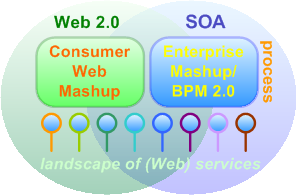Enterprise mashups: More about processes and less about services?

A pair of excellently written and well-reasoned new posts over the last couple of days have focused on a key issue when weaving pre-existing services together into useful new business applications. The result of doing this is often called a composite application in the "enterprisey" world of service-oriented architecture (SOA). And it's called a mashup in the primarily consumer world of Web 2.0. Regardless of name however, both composite apps and mashups are intended to reduce the overall effort of development, improve functionality, promote data consistency, and increase the net output of useful software.
What's not to like about this? In this way, Web 2.0 and SOA often seem to be closely related in terms of connecting people and systems together more easily. And in reality, there is so much overlap in technology, technique, and intent that Web 2.0 and SOA has been described as a true coevolution of concepts. But let's get back to the posts in question...

Enterprise Mashups Will Likely Be More Process-Focused
The value of SOA emerges at the level of processes instead of services?
The first piece is by Ismael Ghalimi, who often talks about applying Business Process Managment or BPM -- a well-known approach for creating business processes that are software assisted -- in a more Web 2.0 fashion. In his write-up, "BPM is SOA's Killer Application", Ismael notes that SOA does indeed turn our IT systems into foundational building blocks; but it's the creation of processes out of them that delivers the actual return on having services in the first place:
From a business standpoint, a service is too small a unit to really appeal to the business side of the house. Its granularity is too fine. And it’s only when elevated to the level of processes that business folks usually start paying attention. Reusing a currency conversion service across multiple applications, and saving three man-month of development along the way, is one thing. Being able to shave three weeks in the overall order-to-cash process is another. Guess which of the two will get the CFO’s attention?
This leads into an excellent piece of analysis in a second insightful post: that today's mashups are primarily focused on data integration instead of creating processes, thereby failing to provide enough directed value in enterprise situations. Peter Rip explores this in detail in his new post, "Meme-check - Enterprise & Web 2.0":
Web 2.0 has been as much about sociology as technology. But Enterprises are not just big "collections of consumers" and so let's not graft the same concepts and expect a thousand enterprise flowers to bloom.
First, dispense with the sociology. Enterprises have two core attributes that do not exist as widely in the public web -- purpose and accountability. So 'empowerment' and 'collective intelligence' are not end points. Nor are 'discovery,' 'networking,' nor 'sharing.' These are embedded in processes and are methods for creating context to purposeful transactions. A sales forecast is 'collective intelligence.' Mining customer comments is a form of 'discovery.' A internal blog post is more likely to be linked to a product release status than photos of my vacation. Viewed in this context, a lot of what passes for (aspiring) businesses in Web 2.0 are simply features of larger processes in the Enterprise.
In the past I've written about the need to provide an enterprise 'context' to Web 2.0 software in order for it to flourish, and in this way both Ismael and Peter provide the perfect synthesis of what enterprise context usually means: Enabling outcome-driven activities, or business processes by any other name. And though the first great mashup tools we're seeing emerge are still primarily about integration of data, it'll be the ones that take it to the next step that might really break out.
A Key Point: We need lighter, more process-oriented tools that are guided by users
Peter closes up his post by observing that we may be in for a revolution as big as what VisiCalc brought us in terms of handing control over IT to users. Specifically, users inputting into collaborative, shared tools that are as easy to use as spreadsheets but that are shared and in the context of larger activities focused on specific outcomes.
And it's this piece, where we find that upfront, excessively structured and complex IT systems are often failing businesses by creating overly rigid automation that isn't user customizable, evolvable, and leaves too much of the result knowledge uncaptured. Enterprise 2.0 is one compelling vision for this and it really is about freeform, collaborative software that adapts to the situation and is controlled primarily by the user, giving workers tools that get out of their way and connect them to their colleagues and their data.
At least that's the vision, and I continue to work at uncovering the emerging tooling for this space. Because we can clearly see that there is are better, more effective ways of working. Ways that we are witnessing on a grand scale in the bustling, vibrant world of collaboration, data sharing, and communities that has become the world of Web 2.0.
I'm looking for great anecdotes, good and both, about the use of blogs, wikis, and social software in the enterprise. If you have a good one, please drop me a line.